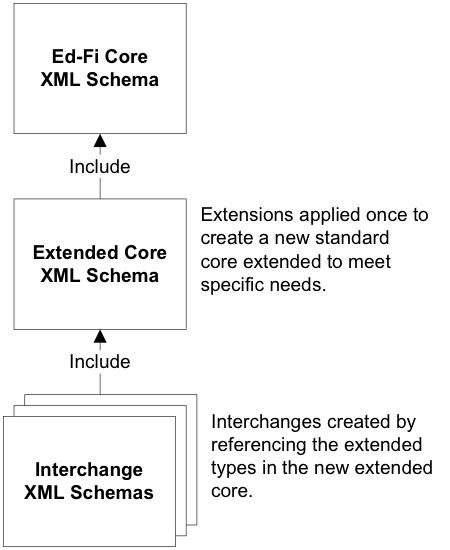This version of the Ed-Fi Data Standard is no longer supported. See the Ed-Fi Technology Version Index for a link to the latest version.
XML Schema - Extensions Framework Guide
Ian Christopher
Ian Christopher (Deactivated)
The Ed-Fi Extension Framework Guidelines
Customizations to the Ed-Fi Core types are explicitly supported for implementation-specific or other purposes using the set of conformant extensions described in this section, known as the "Ed-Fi Extension Framework."
Extensions are made in an extended core. This allows extensions to be defined once and reused across multiple interchange schemas, as well as supports automated code generation.

Options for Extending the Ed-Fi Core Schema
The Ed-Fi Extension Framework defines the following set of conformant methods of customization:
- Customization by Using XML Complex Type Restriction. This technique may be applied to domain or association complex types to:
- Eliminate optional attributes or associations that will never be part of the interchanges
- Set optional attributes or associations to mandatory
- Delete attributes to be replaced through extension
- Customization by Using XML Complex Type Extension. This technique may be applied to domain or association complex types to:
- Add attributes or associations
- Replace attributes deleted by restriction
- Customization by Adding New Complex Types. This technique may be applied to add new domain or association complex types; it is often used to:
- Extend data transfer into new education domains
How-To Articles and Examples
As an example, assume customizations are contemplated by an organization for a student transcript interchange. The use-case is for a student transcript interchange that would be appropriate for a high school or LEA to send to a postsecondary institution. For this interchange, the student transcript should have the following information:
- Student identification and contact information
- Standard No Child Left Behind (NCLB) demographics, omitting any details on disabilities
- K–12 enrollment history indicating the various schools attended
- Academic record showing semester and final grades and credits earned for each secondary course taken
- Scores for the yearly state standardized tests (summary scores only)
- Yearly and final credits earned and grade point average (GPA)
- Graduation plan and date graduated
- The student transcript interchange should indicate whether it is an official or unofficial submission
- Reflects the postsecondary institution(s) that the student is attending
Part 1 through Part 5 demonstrate how to extend the Ed-Fi Core XML Schema and build a custom interchange schema based on the Extended Ed-Fi Core. This series of examples covers every conformant method of customization: